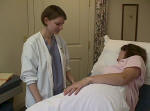|
Learning objectives in obstetrics
and gynecology can be written in a variety of formats and their contents
may vary from institution to institution. These objectives are representative of those from a number of professional and educational institutions.
Antepartum Care
Rationale:
Antepartum care promotes patient education and provides on going risk
assessment and development of an individualized patient management plan.
The student will be able to cite methods to:
-
Diagnose
pregnancy
-
Assess
gestational age
-
Distinguish an at-risk pregnancy
The student will be able to describe
-
Appropriate
diagnostic studies
-
Patient education programs
-
Nutritional needs of
pregnant women
-
Adverse
effects of
drugs and the
environment
The student will be able to
-
Perform a physical
examination on obstetric patients
-
Answer commonly
asked questions concerning pregnancy and
labor and
delivery.
 Intrapartum Care Intrapartum Care
Rationale:
Understanding the process of normal labor and delivery allows optimal
care and reassurance for the parturient and timely recognition of
abnormal events.
The student will be able to describe:
-
Characteristics of true and false labor
-
Initial assessment of the laboring patient
-
Stages and
mechanism of normal labor and delivery
-
Techniques to
evaluate the progress of labor
-
Pain management during labor
-
Methods of monitoring the mother and fetus
-
Management of normal delivery
-
Vaginal repair
-
Indications for operative delivery
-
Immediate postpartum care of the mother.
Postpartum Care
Rationale:
Knowledge of normal postpartum events allows appropriate care,
reassurance, and early recognition of abnormal events.
The student will be able to describe:
-
Normal maternal physiologic changes of the postpartum period
-
Normal postpartum care
-
Appropriate postpartum patient counseling.
Lactation
Rationale: Knowledge of
the physiology and function of the breast during lactation allows
appropriate counseling to the pregnant and postpartum woman.
The student will be able to:
-
List the normal physiologic and anatomic changes of the breast
during pregnancy and the
postpartum periods
-
Recognize and treat common postpartum abnormalities of the breast
-
Know the reasons why breast feeding should be encouraged
-
Recognize commonly used medications which are appropriate and
inappropriate to use while breastfeeding
-
Counsel the lactating patient about commonly asked questions such
as frequency, duration, inadequate production of milk, etc.
Abnormal Labor
Rationale:
Labor is expected to progress in an orderly and predictable manner.
Careful observation of the mother and fetus during labor will allow
early detection of abnormalities so that management can be directed to
optimize outcome.
The student will be able to list:
-
Abnormal labor
patterns
-
Methods of evaluating fetopelvic disproportion
-
Fetal and maternal
complications resulting from abnormal labor
-
Indications and contraindications for oxytocin administration
-
Strategies for management of abnormal fetal presentations
-
Indications for vaginal birth after cesarean delivery
-
Strategies for emergency management of
breech,
shoulder
dystocia, and
cord prolapse
 Preterm Labor Preterm Labor
Rationale:
Prematurity is the most common cause fo neonatal mortality and
morbidity. The reduction of preterm births remains an important goal in
obstetric care. Understanding the causes and recognizing the symptoms of
preterm labor provides the basis for management decisions.
The student will be able to cite:
-
Factors
predisposing to preterm labor
-
Signs and
symptoms of premature uterine contractions
-
Causes of
preterm labor
-
Management of
preterm labor, including tocolytics, steroids, and antibiotics.
Premature Rupture of
Membranes
Rationale: Rupture of the membranes prior to
labor is a problem for both term and preterm pregnancies. Careful
evaluation of this condition may improve fetal and maternal outcome.
The student will be able to describe the following:
-
History, physical findings,
and diagnostic methods to confirm rupture of the membranes
-
Factors predisposing to
premature rupture of membranes.
-
Risks and benefits of
expectant management versus immediate delivery
-
Methods to monitor maternal
and fetal status during expectant management.
Preeclampsia-eclampsia Syndrome
Rationale: Preeclampsia-eclampsia syndrome
accounts for significant morbidity and mortality in both the mother and
newborn.
The student will be able to explain:
-
Definition(s) and classification of hypertension in pregnancy
-
Pathophysiology of preeclampsia-eclampsia syndrome
-
Symptoms, physical findings and diagnostic methods
-
Approach to management
-
Maternal and fetal complications
Spontaneous Abortion
Rationale: Bleeding is common in early pregnancy. A logical approach
to its evaluation may not only affect the outcome of the pregnancy, but
also will help to reassure the patient.
The student will be able to:
-
Develop a differential diagnosis for first-trimester bleeding
-
Distinguish the types of spontaneous abortion
-
Define recurrent abortion
-
Recognize the signs of a missed abortion
-
List complications of spontaneous abortion
-
List causes and complications of septic abortion.
 Third Trimester Bleeding Third Trimester Bleeding
Rationale: Bleeding in the third trimester requires immediate
patient evaluation. Thoughtful, prompt evaluation and management is
necessary to reduce the threat to the lives of the mother and fetus.
The student will be able to:
-
Describe the approach to the patient with third-trimester bleeding
-
Compare symptoms,
physical findings, and diagnostic methods that
differentiate patients with placenta previa and abruptio placenta
-
Describe complications of placenta previa and
abruptio placenta
-
Describe immediate management of shock secondary to
third-trimester bleeding
-
Describe components of the various blood products and indications
for their use.
Pap Smear and Cultures
Rationale: The Pap smear is one of many screening methods used in
medicine. Proper technique in performing the Pap smear and obtaining
specimens for microbiologic culture will improve accuracy.
The student will demonstrate the ability to:
-
Perform an adequate Pap smear
-
Obtain
specimens to detect sexually transmitted diseases
-
Handle specimens properly to improve diagnostic accuracy
-
Provide an explanation to the patient regarding the purpose of
these tests.
Contraception
Rationale: An understanding of the medical and personal issues
involved in decisions regarding contraceptive methods is necessary to
adequately advise patients requesting contraception.
The student will be able to explain:
-
Physiologic or
pharmacologic basis of action
-
Effectiveness
-
Benefits and risks
-
Financial
considerations of the various methods of contraception.
 Climacteric Climacteric
Rationale: Women spend as much as one-third of their lives in the
postmenopausal years. Understanding the physical and emotional changes
caused by estrogen depletion is important for all physicians who
provide health care for women.
The student will be able to describe:
-
Physiologic changes in the hypothalamic-pituitary-ovarian axis.
-
Symptoms and physical findings associated with hypoestrogenism
-
Management, including hormone therapy, nutrition and exercise, and
non-hormonal therapeutic options.
-
Risks and benefits of hormone replacement therapy.
|
Sterilization
Rationale: In the process of deciding whether to have a
sterilization procedure, men and women often seek the advice of their
physicians. Providing accurate information will allow patients to make
an informed decision regarding this elective surgery.
The student will be able to list:
-
Methods of male and female surgical sterilization
-
Risks and benefits of procedures
-
Factors needed to help the patient make informed decisions,
including potential surgical complications, failure rates and
reversibility.
-
Financial considerations
 Abortion Abortion
Rationale: Induced abortion is a reproductive option considered
by some patients. Regardless of one's personal views, the practitioner
should be aware of the techniques, management, and complications of
induced abortions.
The student will be able to list:
-
Surgical and non-surgical pregnancy termination methods
-
Potential complications of abortion, such as hemorrhage and
infection.
-
Psychosocial considerations of abortion.
Sexually Transmitted
Infection
Rationale: To prevent sexually transmitted infections and
minimize their impact on health, the physician should understand their
basic epidemiology, diagnosis and management.
The student will be able to list organisms and methods of
transmission, symptoms, physical findings and evaluation and management
of each of the following::
-
Gonorrhea
-
Chlamydia
-
Herpes simplex virus
-
Syphilis
-
Human papillomavirus infection
-
Human Immunodeficiency virus (HIV) infection
-
Hepatitis B virus infection.
The student will be able to list the public health concerns,
including:
-
Screening programs
-
Costs
-
Prevention and
immunizations
-
Partner evaluation and treatment
Salpingitis
Rationale: The potential impact of acute or chronic salpingitis
is significant. Early recognition and optimal management may help
prevent the long-term sequelae of tubal disease.
The student will be able to describe:
-
Pathogenesis
-
Common organisms
-
Signs and symptoms
-
Methods of diagnosis
-
Treatment
-
Sequelae, including tuboovarian abscess, chronic salpingitis,
ectopic pregnancy, and infertility.
Endometriosis
Rationale: Endometriosis is a common problem of women of
reproductive age, which may result in pelvic pain, infertility and
menstrual dysfunction.
The student will be able to describe:
-
Theories of pathogenesis
-
Symptoms and physical findings
-
Common sites of implants
-
Methods of diagnosis
-
Non-surgical and surgical management
Normal and Abnormal Bleeding
Rationale: The occurrence of bleeding at times other than
expected menses is a common event. Accurate diagnosis of abnormal
uterine bleeding is necessary for appropriate management.
The student will be able to:
-
Describe endocrinology and physiology of the normal menstrual
cycle
-
Distinguish abnormal uterine bleeding from dysfunctional uterine
bleeding
-
List causes of abnormal uterine bleeding
-
Evaluate and diagnose abnormal uterine bleeding
-
Describe therapeutic options.
 Uterine Leiomyomas Uterine Leiomyomas
Rationale: Uterine leiomyomas represent the most common
gynecologic neoplasm and are often asymptomatic.
The student will be able to describe the following:
-
Prevalence of uterine leiomyomas
-
Symptoms and
physical findings
-
Methods to confirm the diagnosis
-
Indications for medical and surgical treatment
Ectopic Pregnancy
Rationale: Ectopic pregnancy is a leading cause of maternal
morbidity and mortality in the Unites States. Early diagnosis and
management may not only save lives, but may also preserve future
fertility.
The student will be able to:
-
Develop a differential diagnosis of first-trimester bleeding
-
List risk factors predisposing patients to ectopic pregnancy
-
Describe symptoms and physical findings suggestive of ectopic
pregnancy
-
Understand methods and test used to confirm the diagnosis of
ectopic pregnancy
-
Explain treatment options
Disorders of the Breast
Rationale: Every physician should understand the basic approach
to evaluating the common symptoms associated with the breast.
The student will be able to describe:
-
Standards of surveillance of an adult woman, including breast
self-examination, physical examination and mammography.
-
Diagnostic approach to a woman with the chief complaint of
breast
mass, nipple discharge, and
breast pain.
The student will be able to describe the history and physical
findings that might suggest the following abnormalities:
-
Intraductal papilloma
-
Fibrocystic changes
-
Fibroadenoma
-
Carcinoma
-
Mastitis
The student will be able to
teach a woman how to perform breast
self-examination.
Cervical Disease and
Neoplasia
Rationale: Detection and treatment of preinvasive lesions reduces
the medical and social costs of, as well as the mortality associated
with, carcinoma of the cervix.
The student will be able to describe:
-
Risk factors of cervical disease and neoplasia
-
Indications for screening.
-
Symptoms and physical findings of
cervicitis and
neoplasia
-
Evaluation and management of the patient with an abnormal pap
smear.
-
Impact of staging on management and prognosis
Endometrial Carcinoma
Rationale: Endometrial carcinoma is the most common gynecologic
malignancy.
The student will be able to describe:
-
Risk factors for endometrial carcinoma
-
Symptoms and physical findings
-
Management of the patient with postmenopausal bleeding
-
Methods to diagnose endometrial carcinoma
-
Impact of staging on management and prognosis
-
Management of the patient with endometrial cancer
Ovarian Neoplasms
Rationale: Adnexal masses are a common finding in both
symptomatic and asymptomatic patients. Management is based on
determining the origin and character of these masses.
The student will be able to describe:
-
Evaluation of the patient with an adnexal mass
-
Characteristics of ovarian neoplasms
-
Evaluation and management of carcinomas of the ovary
-
Symptoms and physical findings
-
Risk factors
-
Histologic classification
-
Impact of staging on management and prognosis
Sexual Assault
Rationale: Individuals who are the victims of sexual assault
often have significant physical and emotional sequelae.
The student will be able to explain the medical, forensic,
psychological evaluation and treatment and followup of::
-
Child sexual assault victim
-
Adult sexual assault victim
-
Acquaintance rape
 Domestic Violence Domestic Violence
Rationale: Domestic violence affects a significant proportion of
the U.S. population in all economic classes and walks of life. All
physicians should screen for the presence of domestic violence.
The student will be able to:
-
Cite prevalence and incidence of violence against women, elder
abuse, child abuse.
-
Assess the involvement of any patient in domestic violence
situations.
-
Counsel patients for short term safety.
-
Counsel patients regarding local support agencies for long term
management and resources.
-
Counsel patients requiring resources for batterers and
perpetrators of domestic violence.
|